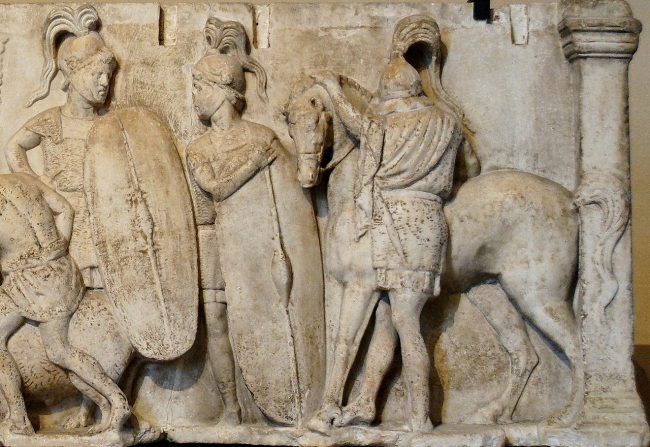
The Roman Republic was one of the longest-lasting, most powerful political institutions of the ancient world. It lasted from the overthrow of the Etrusco-Roman king Tarquin the Proud in 509 BC through to around 27 BC when Octavian was first styled Augustus by the Roman senate.
And yet a single, seminal event in 107 BC set in train a sequence of events that was to see it crash out of existence as the optimates reactionary party and the populares reformers fought a series of vicious civil wars in the 1st century BC.
Roma invicta
The Roman Republic was a militaristic institution that had grown exponentially from its Italian roots to dominate both the western and eastern Mediterranean. It had seen off the might of Carthage and destroyed many of the Hellenistic kingdoms in the Balkans and Levant.
This was not always a smooth process. Rome often lost battles, but always came back, displaying that most Roman of characteristics, grit. And yet in the last decade of the 2nd century BC it was being tested as never before, excepting perhaps against its one time nemesis Hannibal.

A detail of the carved relief on the Altar of Domitius Ahenobarbus, depicting pre-Marian Roman soldiers: 122-115 BC.
The coming of the Cimbrians
This was in the context of the Cimbrian War which lasted from 113 to 101 BC. Here, Rome found itself fighting the Germanic Cimbrians and their allies in southern and southeastern Gaul. The Republic suffered defeat after defeat, some catastrophic. Panic gripped Rome, with the phrase terror cimbricus being used to describe the mood of the people.
Then in 107 BC a saviour emerged. This was Gaius Marius, elected consul for the first time that year, the first of seven times he held the office. He surveyed the debris of Rome’s military response to the crisis and concluded that the main issue was the organisation of the legions themselves.
He felt them too unwieldy for this new kind of warfare, fighting hoards of ‘barbarians’ marauding across the countryside in their many thousands.
He therefore resolved to turn each individual legion into a self-contained fighting force, with little or no supply train. In that way they could manoeuvre at a strategic level more quickly than their opponents, bringing them to battle on the best terms.
 Watch Now
Watch NowHow did Marius reform the Roman military?
In the first instance he standardised the legionary on the gladius and pilum-armed armed principes and hastati of the Polybian legions, with the spear-armed triarii and javelin-armed velites disappearing entirely.
From that point all of the fighting men in a legion were simply called legionaries, numbering 4,800 out of a total 6,000 men in each legion. The remaining 1,200 troopers were support personnel. These carried out a wide variety of roles, ranging from engineering to administration, which enabled the legion to function autonomously.

A painting depicting the Battle of Vercellae in 101 BC, where Marius defeated the Cimbri with his newly-reformed legions.
The main advantages of the new Marian legions, their lack of a need for long lines of supply and a streamlined organisation, enabled the Romans to ultimately win the Cimbrian War. Soon the slave markets of Rome were full of Germans. Yet it was this newly instituted military organisation that ultimately gave rise to a new phenomenon at the top of Roman society.
This was the the late Republican warlord; think Marius himself, Sulla, Cinna, Pompey, Crassus, Caesar, Mark Anthony and Octavian. These were military leaders who often operated without the consent of the Senate and other political institutions of Rome, sometimes against the opponents of the Republic, but often – and increasingly – against each other in a never-ending spiral of civil war that ultimately saw all in the Republic desperate for peace.
This they found in Octavian who established the Principate Empire as Augustus, his pax Romana reflecting the desire for stability.
 Watch Now
Watch NowThe specific reasons why the Marian legions enabled these warlords to operate in this way were:
1. It proved easy for the warlords to build huge armies
They were able to amalgamate legions given they were individually so autonomous.
2. Marius removed the property requirement to serve in the legions
This opened their ranks to the lower end of Roman society. With little money of their own, such troops proved to be very loyal to their warlords providing they were paid.
 Listen Now
Listen Now3. The creation of many new legions increased the opportunity for promotion
The warlords could promote the centurions of an existing legion to be the officers in a new one, and the senior legionaries to be similarly promoted, this time as the centurion in the new unit. This again ensured intense loyalty. Caesar was the best exemplar here.
4. There was money to be made for the legionaries over and above their salaries if their warlords were successful
This was especially true when they were campaigning in the east where the vast wealth of the former Hellenistic kingdoms was on offer to victorious Roman warlords and their legions. Here, the new legionary organisation proved particularly successful against all-comers.
Thus fell the Roman Republic. It is no surprise that one of Octavian’s first moves on becoming the victor after the final bout of civil wars was to drastically cut the number of legions he inherited – around 60 – to a more manageable 28. After that, with his gradual accruing of political power in Rome, no more were the legions to threaten the stability of the Roman political order.
Dr Simon Elliott is an historian and archaeologist who has written widely on Roman themes.














